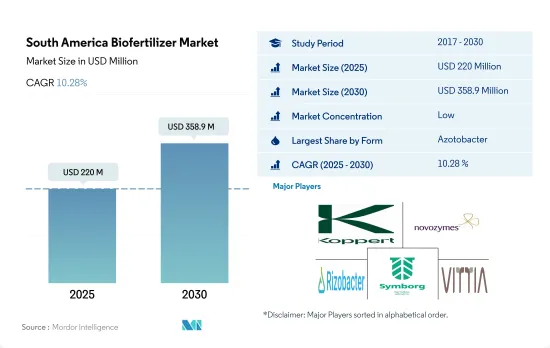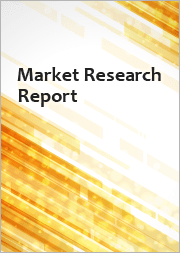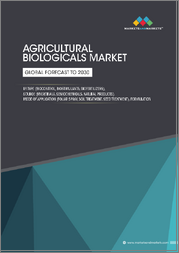
|
시장보고서
상품코드
1693780
남미의 바이오 비료 시장 : 시장 점유율 분석, 산업 동향 및 통계, 성장 예측(2025-2030년)South America Biofertilizer - Market Share Analysis, Industry Trends & Statistics, Growth Forecasts (2025 - 2030) |
||||||
■ 보고서에 따라 최신 정보로 업데이트하여 보내드립니다. 배송일정은 문의해 주시기 바랍니다.
남미의 바이오 비료 시장 규모는 2025년에는 2억 2,000만 달러에 이르고, 2030년에는 3억 5,890만 달러에 달할 것으로 예상되며, 예측 기간 중(2025-2030년) CAGR은 10.28%를 나타낼 것으로 전망됩니다.

- 바이오 비료는 식물의 성장과 생산성을 높이는 지속 가능하고 생태 친화적인 방법입니다. 가장 일반적으로 사용되고 있는 바이오 비료에는 마이코리자, 아조스피릴룸, 아조토박타, 리조븀, 인산 가용화 세균 등이 있습니다.
- 이러한 미생물은 토양의 건전성과 비옥도를 향상시키고 작물에 필요한 영양소를 공급하는 능력을 위해 선택됩니다.
- 아조토박터는 이 지역에서 소비되는 바이오 비료 전체의 28.6%를 차지하고 있습니다. 전형적인 농장 환경에서는 아조토박터를 접종하는 것으로, 이러한 작물에 있어서의 질소 비료의 필요성이 10-20% 감소합니다.
- 브라질의 조사에서는 Azospirillum brasilense의 Ab-V5와 Ab-V6의 2주를 조합하는 것으로, 대두, 사탕수수, 쌀, 밀, 목초 등의 주요 작물의 수량이 증가하는 것이 실증되고 있습니다.
- 이 지역의 바이오 비료 시장은 유기 재배 식품에 대한 수요의 높아짐과 토양과 환경을 보다 안전하게 유지하기 위한 지속 가능한 농법의 중요성을 정부가 강조하고 있기 때문에 성장이 전망되고 있습니다.
- 브라질은 남미 유수의 농업국으로 2022년에는 이 지역의 바이오 비료 시장 전체의 65.3%를 차지했습니다.
- 이 지역의 유기농 작물 재배 면적은 2017년 49만 5,700헥타르에서 2021년에는 71만 7,200헥타르로 증가하였습니다.
- 토양 오염과 환경 오염에 대한 우려가 높아지는 가운데 정부와 기타 단체는 이 지역 전체에서 생물학적 작물 투입물의 사용을 강력히 추진하고 있습니다. 농약의 사용 삭감에 중점을 두고, 농업 경제적인 방법을 이용해, 보다 효율적이고 지속 가능한 농업 식품 시스템에의 전환을 우선하고 있습니다. 이것은 보다 지속 가능한 대체 수단으로서 바이오 비료를 채용하는 기회를 여는 것
- 또한, 콩과 작물의 수확량도 현저하게 증가하고 있습니다. 이오비료 사용의 장점은 남미에서의 사용을 촉진할 것으로 예측됩니다.
남미의 바이오 비료 시장 동향
콩, 옥수수, 해바라기, 밀의 국제 수요 증가로 인한 유기 재배 면적 증가
- The Research Institute of Organic Agriculture(FibL 통계)가 제공한 데이터에 따르면 남미에서 작물의 유기 재배 면적은 2021년에 67만 2,800헥타르로 기록되었습니다. 아르헨티나는 2021년에 이 지역의 유기 재배 면적의 11.5%의 점유율을 차지했습니다.
- 2021년의 유기농 작물 재배 면적은 38만 4,300헥타르로 현금 작물이 53.9%로 최대의 점유율을 차지했습니다.
- 한편, 우루과이는 이 지역에서 유기농 야채와 과일의 재배가 활발합니다. 2022년에 5,139명의 농업 종사자가 기후 변화 대응형 농업(CSA)을 도입하는 것을 지원해, 이 지역의 유기 작물의 재배 면적 증가에 공헌했습니다.
- 남미에서는 수백만의 농업 종사자가 외부에서의 투입물을 사용하지 않는 농업을 계속하고 있어 국내 생산이 현저히 낮음에도 불구하고, 이 지역 경제의 장래를 담당할 가능성은 충분히 있습니다.
아르헨티나, 브라질, 콜롬비아 소비자의 약 49.0%가 유기농 식품 구매에 관심을 가지고 있습니다.
- 남미는 세계적으로 봐도 유기농 식품의 중요한 생산·수출국 중 하나입니다.
- 아르헨티나, 브라질, 콜롬비아 등 남미 국가에서는 유기농 식품과 같은 자연 재배 제품에 대한 수요가 높아지고 있습니다.
- 2021년 Global Organic Trade의 데이터에 따르면 아르헨티나의 유기 제품 시장은 2021년에 1,590만 달러에 달했고, 세계 시장 규모의 0.03%를 차지했으며, 1인당 소비액은 0.35 USD이었습니다.
- 현재이 지역의 유기농 식품 시장은 매우 세분화되어 있으며 일부 슈퍼마켓과 전문점으로 제한됩니다. 현재 코스타리카, 멕시코, 남미 도시를 중심으로 이 지역의 많은 슈퍼마켓, 전문점, 현지 파머스 마켓이 유기농 식품을 판매하고 잠재적인 수요 증가에 부응하고 있습니다. 소비자 의식 증가와 구매 동기는 이 지역의 유기농 식품의 지속가능성 특성에 대한 이해를 깊게할 것으로 예측됩니다.
남미의 바이오 비료 산업 개요
남미의 바이오 비료 시장은 부문화되어 상위 5개사에서 19.47%를 차지하고 있습니다. 이 시장의 주요 기업은 Koppert Biological Systems Inc., Novozymes, Rizobacter, Symborg Inc., Vittia Group 등입니다.
기타 혜택
- 엑셀 형식 시장 예측(ME) 시트
- 3개월의 애널리스트 서포트
목차
제1장 주요 요약과 주요 조사 결과
제2장 보고서 제안
제3장 서론
- 조사의 전제조건과 시장 정의
- 조사 범위
- 조사 방법
제4장 주요 산업 동향
- 유기 재배 면적
- 1인당 유기농 제품에 대한 지출
- 규제 프레임워크
- 아르헨티나
- 브라질
- 밸류체인과 유통채널 분석
제5장 시장 세분화
- 형태
- 아조스피릴룸
- 아조토박터
- 마이코리자
- 인산염 가용화 박테리아
- 리조비움
- 기타 바이오 비료
- 작물 유형
- 환금작물
- 원예작물
- 경작작물
- 국가명
- 아르헨티나
- 브라질
- 기타 남미
제6장 경쟁 구도
- 주요 전략 동향
- 시장 점유율 분석
- 기업 상황
- 기업 프로파일
- Atlantica Agricola
- IPL Biologicals Limited
- Koppert Biological Systems Inc.
- Novozymes
- Plant Response BIoTech Inc.
- Rizobacter
- Sustane Natural Fertilizer Inc.
- Symborg Inc.
- T.Stanes and Company Limited
- Vittia Group
제7장 CEO에 대한 주요 전략적 질문
제8장 부록
- 세계 개요
- 개요
- Five Forces 분석 프레임워크
- 세계의 밸류체인 분석
- 시장 역학(DROs)
- 정보원과 참고문헌
- 도표 일람
- 주요 인사이트
- 데이터 팩
- 용어집
The South America Biofertilizer Market size is estimated at 220 million USD in 2025, and is expected to reach 358.9 million USD by 2030, growing at a CAGR of 10.28% during the forecast period (2025-2030).

- Biofertilizers are a sustainable and eco-friendly way of enhancing plant growth and productivity. They are composed of living microorganisms that can improve the soil's nutrient content, making essential elements more accessible to plants. Some of the most commonly used biofertilizers include mycorrhiza, Azospirillum, Azotobacter, Rhizobium, and phosphate-solubilizing bacteria.
- These microorganisms are selected for their ability to improve the soil's health and fertility, providing crops with the nutrients required. They work by either breaking down organic matter to release essential nutrients or directly increasing the availability of specific nutrients in the soil.
- Azotobacter accounted for 28.6% of the total biofertilizers consumed in the region. Field tests on Azotobacter under various agro-climatic conditions revealed that the biofertilizer is suitable for inoculating with seeds or seedlings of crops such as onion, tomato, and cabbage. Under typical field circumstances, Azotobacter inoculation reduces the need for nitrogenous fertilizers in these crops by 10-20%. Thus, the usage of Azotobacter in agriculture is expected to grow in the coming years.
- Research in Brazil has demonstrated that the combination of two strains of Azospirillum brasilense, Ab-V5 and Ab-V6, increased yields in key crops such as soybean, sugarcane, rice, wheat, and pasture. The application of these two strains is also compatible with other pesticides commonly used in these crops.
- The market for biofertilizers in the region is expected to grow due to the rising demand for organically-grown food and the government's emphasis on the importance of sustainable agricultural practices to keep the soil and environment safer.
- Brazil is a leading agriculture nation in South America and held 65.3% of the total biofertilizer market in the region in 2022. The country's farmers are keeping up with the worldwide demand for organic food and achieved organic food sales worth USD 81.0 million in 2021, which rose 9.5% compared to the previous year, as per the Global Organic Trade.
- The area under cultivation of organic crops in the region increased from 495.7 thousand hectares in 2017 to 717.2 thousand hectares in 2021. The increasing trend in the overall organic crop is expected to drive the market for biofertilizers in these countries and is estimated to register a CAGR of 10.0% between 2023 and 2029.
- With growing concern for soil and environmental pollution, the government and other organizations are highly promoting the usage of biological crop inputs across the region. In Argentina, the FAO's 2022-2031 Strategic Framework prioritizes transforming agri-food systems to be more efficient and sustainable, using agroeconomic methods, with a focus on reducing the use of chemical fertilizers and pesticides in agriculture. This opens up opportunities for adopting biofertilizers as a more sustainable alternative.
- Moreover, there has been a remarkable increase in the crop yield of leguminous crops. Strains of rhizobium produce growth hormones like indole acetic acid, which influences positive growth in plants by stimulating the formation and development of root nodules quickly. The advantages of biofertilizer usage are expected to drive their usage in South America. However, less awareness among the farmers and the long transition period from chemical farming to organic farming are slightly hindering the market growth of biofertilizers.
South America Biofertilizer Market Trends
Growing organic acreage owning to the rising international demand for soy, corn, sunflower, and wheat.
- The area under organic cultivation of crops in South America was recorded at 672.8 thousand hectares in 2021, according to the data provided by The Research Institute of Organic Agriculture (FibL statistics). Argentina and Uruguay are the major organic-producing countries in the region, with a large area under organic crop cultivation, with Argentina occupying a share of 11.5% of the organic area in the region in 2021. The primary organic crops produced in Argentina include sugarcane, raw wool, fruits, vegetables, and beans. The primary organic exports are soy, corn, sunflower, and wheat.
- Cash crops accounted for the maximum share of 53.9% under organic crop cultivation in 2021, with 384.3 thousand hectares of land. The region is a major grower of cash crops like sugarcane, cocoa, coffee, and cotton. Brazil is the largest sugarcane-growing country in the region.
- On the other hand, Uruguay is a large grower of organic fruits and vegetables in the region. The Organic Farmers' Association of Uruguay promotes organic cultivation in the country by partnering with various organic retail outlets. The World Bank-financed Sustainable Management of Natural Resources and Climate Change project (DACC) assisted 5,139 farmers in 2022 to adopt climate-smart agriculture (CSA), which helped increase the area under cultivation of organic crops in the region.
- Millions of farmers in South America continue to practice no-external input agriculture, which may very well represent the future of the region's economy despite the noticeably low domestic production. The population is becoming more health conscious, which creates a larger market for South America's increasingly eco-friendly and sustainable farming system.
Approximately 49.0% consumers in Argentina, Brazil and Colombia are interested in purchasing organic food.
- South America is one of the important producers and exporters of organic food products globally. The per capita spending on organic food products in South America is comparatively lesser than in other parts of the world. The average per capita spending was recorded as USD 4.3 in 2022. Nevertheless, these export-oriented countries are now generating an often-overlooked domestic demand.
- The demand for naturally grown products like organic food in South American countries like Argentina, Brazil, and Colombia has increased. A survey conducted by Wisconsin Economic Development in 2021 proved that consumers are willing to pay higher prices for organically grown food. The study revealed that 43-49% of consumers are conscious about their health. Brazil ranks 43rd globally for per capita spending on organic packaged food and beverages.
- The organic products market in Argentina reached a value of USD 15.9 million in 2021, representing 0.03% of the global market value, with a per capita consumption of USD 0.35, as per the data given by Global Organic Trade in 2021.
- Currently, the market for organic foods in the region is very fragmented, with its availability limited to a few supermarkets and specialty stores, as only people from higher-income families are potential customers. Many supermarkets, specialized stores, and local farmers' markets in the region are now selling organic food to satisfy the growing latent demand for such products, mainly in Costa Rica, Mexico, and urban centers of South America. Growing awareness among consumers and their buying motives are expected to lead to a better understanding of the sustainability attributes of organic food in the region.
South America Biofertilizer Industry Overview
The South America Biofertilizer Market is fragmented, with the top five companies occupying 19.47%. The major players in this market are Koppert Biological Systems Inc., Novozymes, Rizobacter, Symborg Inc. and Vittia Group (sorted alphabetically).
Additional Benefits:
- The market estimate (ME) sheet in Excel format
- 3 months of analyst support
TABLE OF CONTENTS
1 EXECUTIVE SUMMARY & KEY FINDINGS
2 REPORT OFFERS
3 INTRODUCTION
- 3.1 Study Assumptions & Market Definition
- 3.2 Scope of the Study
- 3.3 Research Methodology
4 KEY INDUSTRY TRENDS
- 4.1 Area Under Organic Cultivation
- 4.2 Per Capita Spending On Organic Products
- 4.3 Regulatory Framework
- 4.3.1 Argentina
- 4.3.2 Brazil
- 4.4 Value Chain & Distribution Channel Analysis
5 MARKET SEGMENTATION (includes market size in Value in USD and Volume, Forecasts up to 2030 and analysis of growth prospects)
- 5.1 Form
- 5.1.1 Azospirillum
- 5.1.2 Azotobacter
- 5.1.3 Mycorrhiza
- 5.1.4 Phosphate Solubilizing Bacteria
- 5.1.5 Rhizobium
- 5.1.6 Other Biofertilizers
- 5.2 Crop Type
- 5.2.1 Cash Crops
- 5.2.2 Horticultural Crops
- 5.2.3 Row Crops
- 5.3 Country
- 5.3.1 Argentina
- 5.3.2 Brazil
- 5.3.3 Rest of South America
6 COMPETITIVE LANDSCAPE
- 6.1 Key Strategic Moves
- 6.2 Market Share Analysis
- 6.3 Company Landscape
- 6.4 Company Profiles (includes Global Level Overview, Market Level Overview, Core Business Segments, Financials, Headcount, Key Information, Market Rank, Market Share, Products and Services, and Analysis of Recent Developments).
- 6.4.1 Atlantica Agricola
- 6.4.2 IPL Biologicals Limited
- 6.4.3 Koppert Biological Systems Inc.
- 6.4.4 Novozymes
- 6.4.5 Plant Response Biotech Inc.
- 6.4.6 Rizobacter
- 6.4.7 Sustane Natural Fertilizer Inc.
- 6.4.8 Symborg Inc.
- 6.4.9 T.Stanes and Company Limited
- 6.4.10 Vittia Group
7 KEY STRATEGIC QUESTIONS FOR AGRICULTURAL BIOLOGICALS CEOS
8 APPENDIX
- 8.1 Global Overview
- 8.1.1 Overview
- 8.1.2 Porter's Five Forces Framework
- 8.1.3 Global Value Chain Analysis
- 8.1.4 Market Dynamics (DROs)
- 8.2 Sources & References
- 8.3 List of Tables & Figures
- 8.4 Primary Insights
- 8.5 Data Pack
- 8.6 Glossary of Terms
샘플 요청 목록



















